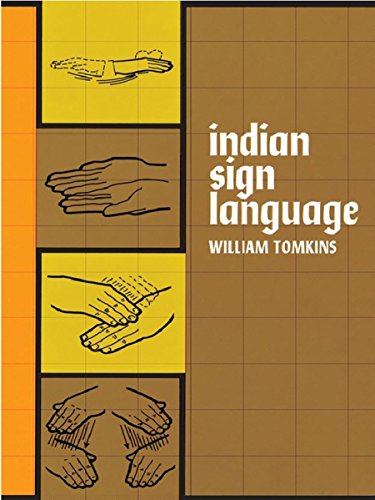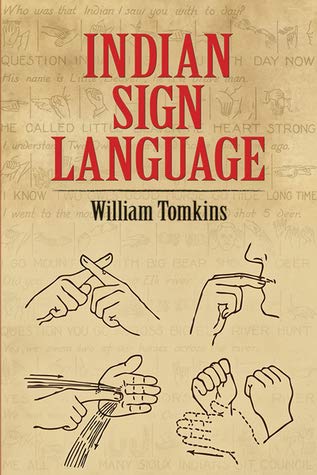-
Indian Sign Language
William Tomkins
Paperback (Dover Publications, June 1, 1969)Plains Indians from different tribes speaking different languages were nevertheless able to communicate facts and feelings of considerable complexity when they met. They used a language composed of gestures made almost entirely with the hands and fingers, probably the most highly developed gesture language to be found in any part of the world.With this book, you will find it simple to use this language, which the author learned in the late nineteenth and early twentieth centuries, principally from Sioux Indians in Wyoming. Drawings and short descriptions make clear the proper positions and motions of the hands to convey the meaning of over 870 alphabetically arranged common words — hungry, camp, evening, angry, fire, laugh, owl, cat, many times, brave, cold, heart, rain, spotted, together, river, etc. The words are then used in sample sentences. There are also brief sections on the pictography and ideography of the Sioux and Ojibway tribes, and on smoke signals.This is a book for anyone who wants to learn or teach Indian sign language — scouts, school teachers, camp counselors, scout leaders, parents, linguists, and students of Indian culture. To help counselors and teachers, the last chapters give instructions on how to conduct the Indian ceremony for opening a council fire, an Indian initiation ceremony, and suggestions for sign language tests and exercises. X
X
-
Indian Sign Language
William Tomkins
eBook (Dover Publications, April 20, 2012)Plains Indians from different tribes speaking different languages were nevertheless able to communicate facts and feelings of considerable complexity when they met. They used a language composed of gestures made almost entirely with the hands and fingers, probably the most highly developed gesture language to be found in any part of the world.With this book, you will find it simple to use this language, which the author learned in the late nineteenth and early twentieth centuries, principally from Sioux Indians in Wyoming. Drawings and short descriptions make clear the proper positions and motions of the hands to convey the meaning of over 870 alphabetically arranged common words — hungry, camp, evening, angry, fire, laugh, owl, cat, many times, brave, cold, heart, rain, spotted, together, river, etc. The words are then used in sample sentences. There are also brief sections on the pictography and ideography of the Sioux and Ojibway tribes, and on smoke signals.This is a book for anyone who wants to learn or teach Indian sign language — scouts, school teachers, camp counselors, scout leaders, parents, linguists, and students of Indian culture. To help counselors and teachers, the last chapters give instructions on how to conduct the Indian ceremony for opening a council fire, an Indian initiation ceremony, and suggestions for sign language tests and exercises.
-
The Indian Sign Language
William Philo Clark
eBook (BIG BYTE BOOKS, Oct. 29, 2015)William Philo Clark's classic work on Native American signs and culture is still considered a monumental achievement. Published posthumously after the young Clark died in 1884, it covers the words and phrases of many tribes.Clark was with General George Crook in late summer of 1876 during the Sioux War and later served on staff assignments for General Phil Sheridan.Now you can use this reference to learn signs and compare them to American Sign Language.For the first time, this long out-of-print volume is available as an affordable, well-formatted book for e-readers and smartphones. Be sure to LOOK INSIDE by clicking the cover above or download a sample.
-
Sign Language
Lora Heller
Board book (Sterling Children's Books, March 4, 2014)Title: Sign Language Binding: Board Books Author: LoraHeller Publisher: Sterling E
E
-
The Indian Sign Language
William Philo Clark
Paperback (Independently published, Aug. 4, 2017)William Phil Clark's classic work on Native American signs and culture is still considered a monumental achievement. Published posthumously after the young Clark died in 1884, it covers the words and phrases of many tribes. Clark was with General George Crook in late summer of 1876 during the Sioux War and later served on staff assignments for General Phil Sheridan. Now you can use this reference to learn signs and compare them to American Sign Language.
-
Indian Signals and Sign Language
George Fronval
Hardcover (Wings, July 1, 1991)Explains how to use the sign language and signals of the American Indians to communicate feelings and describe events U
U
-
The Indian Sign Language
W. P. Clark
Paperback (University of Nebraska Press, April 1, 1982)In 1876 and 1877, Captain W. P. Clark commanded a detachment of Indian scouts—including Pawnees, Shoshones, Arapahoes, Cheyennes, Crows, and Sioux—who conversed in sign language. They made requests, relayed information, and told stories with their hands, communicating in a language indispensable for quick understanding between Indians of different tribes. The scouts patiently taught Clark the sign system, which he patiently recorded in this book. Originally written in 1884 for use by the United States Army, The Indian Sign Language is far more than a grammar book or curiosity. Clark worked closely with the Indians who taught him the language, and his respect for them and their way of thinking informs every page. Written for future officers in Indian regions, The Indian Sign Language corrects the sentimental and brutal stereotypes of Indians that led to much misunderstanding.Clark believed that sign language could assist him "to think like the Indians," which he considered essential for a conscientious officer. His book discusses reliably and soberly the facts of plains Indian life as he encountered them in the 1870s and 1880s. Now a classic, The Indian Sign Language is a monument to the desire for understanding between radically different peoples.
-
The Indian Sign Language
William P. Clark
Hardcover (Kessinger Publishing, LLC, Sept. 10, 2010)This scarce antiquarian book is a facsimile reprint of the original. Due to its age, it may contain imperfections such as marks, notations, marginalia and flawed pages. Because we believe this work is culturally important, we have made it available as part of our commitment for protecting, preserving, and promoting the world's literature in affordable, high quality, modern editions that are true to the original work.
-
Indian Sign Language
William Tomkins
Paperback Bunko (Dover Publications, Jan. 1, 1711)Indian Sign Language (Native American) by William Tomkins (1969-06-01) [paperback] William Tomkins [Jan 01, 1711]
-
North American Indian Sign Language
Karen Liptak
Library Binding (Franklin Watts, Sept. 1, 1990)Describes the basic vocabulary needed to communicate in the most commonly used form of sign language used among North American Indians. S
S
-
Indian Sign Language
William Tomkins
Hardcover (Dover Pubns, Jan. 1, 1969)None
-
Indian Sign Language
William Tomkins
Library BindingINDIAN SIGN LANGUAGE This book is a used library book, without a dustjacket, a library pocket on the first page, and yellowing of the pages. There are no markings, writing or highlighting. This book is autographed by the author, William Tomkins.